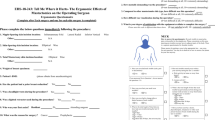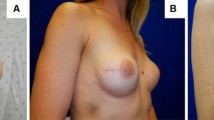Abstract
Background
Nipple-sparing mastectomy (NSM) is more technically challenging than skin-sparing mastectomy (SSM) but offers quality-of-life and cosmetic advantages. However, surgeon physical symptoms related to NSM workload have not been documented.
Methods
This was a prospective study using questionnaires to compare surgeon-reported physical symptoms before, during, and after NSM versus SSM. Surgeons also answered general questions about each mastectomy. Bilateral cases were performed simultaneously by two surgeons, who completed independent questionnaires.
Results
Questionnaires were completed after 82 SSMs and 44 NSMs. On a 0–10 scale, surgeons reported NSM was more physically demanding than SSM (7.0 vs. 4.5, p < 0.001). Mean visualization was more difficult (5.7 vs. 3.2, p < 0.001) and mean fatigue score was greater (5.6 vs. 3.1, p < 0.001) after NSM than SSM. The mean increase in neck pain (on a 0–4 scale) was greater for NSM than SSM, both from before-to-during surgery (0.8 vs. 0.2, p = 0.003) and before-to-after surgery (0.9 vs. 0.2, p = 0.002). The mean increase in lower back pain was greater for NSM than SSM, both from before-to-during surgery (0.7 vs. 0.2, p = 0.008) and before-to-after surgery (0.9 vs. 0.2, p = 0.003). Surgeons reported that NSM was more mentally demanding (p < 0.001), complex (p = 0.01), and difficult (p < 0.001) than SSM.
Conclusion
Surgeons experienced greater physical symptoms, mental strain, and fatigue with NSM than SSM. This raises concern that mild but repetitive pain over the course of a breast surgeon’s career may lead to repetitive stress injury.

Similar content being viewed by others
References
Metcalfe KA, Cil TD, Semple JL, Li LD, Bagher S, et al. Long-term psychological functioning in women with bilateral prophylactic mastectomy: does preservation of the nipple-areolar complex make a difference? Ann Surg Oncol. 2015; 10:3324–30.
Sisco M, Kyrillos AM, Lapin BR, et al. Trends and variation in the use of nipple-sparing mastectomy for breast cancer in the United States. Breast Cancer Res Treat. 2016; 160(1):111–20.
Paepke S, Schmid R, Fleckner S, Paepke D, Niemeyer M, et al. Subcutaneous mastectomy with conservation of the nipple-areola skin. Ann Surg. 2009; 250:288–92.
Fortunato L, Loreti A, Andrich R, Costarelli L, Amini M, et al. When mastectomy is needed: is the nipple-sparing procedure a new standard with very few contraindications? J Surg Oncol. 2013; 108:207–12.
Coopey SB, Tang R, Lei L, Freer PE, Kansal K, et al. Increasing eligibility for nipple-sparing mastectomy. Ann Surg Oncol. 2013; 20:3218–22.
Krajewski AC, Boughey JC, Degnim AC, Jakub JW, Jacobson SR, et al. Expanded indications and improved outcomes for nipple-sparing mastectomy over time. Ann Surg Oncol. 2015; 10:3317–23.
Burdge EC, Yuen J, Hardee M, Gadgil PV, Das C, et al. Nipple skin-sparing mastectomy is feasible for advanced disease. Ann Surg Oncol. 2013; 20:3294–302.
Peled AW, Wang F, Foster RD, Alvarado M, Ewing CA, et al. Expanding the indications for total skin-sparing mastectomy: is it safe for patients with locally advanced disease? Ann Surg Oncol. 2015; 23(1):87–91.
Schneider LF, Chen CM, Stolier AJ, Shapiro RL, Ahn CY, et al. Nipple-sparing mastectomy and immediate free-flap reconstruction in the large ptotic breast. Ann Plast Surg. 2012; 69:425–8.
Jackson RS, Buras R, Tafra L. Patient selection and breast imaging. In: Harness JK, Willey SC, et al editors. Operative approaches to nipple-sparing mastectomy. Switzerland: Springer; 2017. p. 21–36.
Szeto GP, Ho P, Ting AC, et al. Work-related musculoskeletal symptoms in surgeons. J Occup Rehabil. 2009; 19(2):175–84.
Park A, Lee G, Seagull J, et al. Patients benefit while surgeons suffer: an impending epidemic. J Am Coll Surg. 2010; 210(3): 306–13.
Matern U, Koneczny S. Safety, hazards and ergonomics in the operating room. Surg Endosc. 2007; 21(11):1965–9.
Boneti C, Yuen J, Santiago C, et al. Oncologic safety of nipple skin-sparing or total skin-sparing mastectomies with immediate reconstruction. J Am Coll Surg. 2011; 212:686–95.
Kuorinka I, Jonsson B, Kilbom A, et al. Standardised nordic questionnaires for the analysis of musculoskeletal symptoms. Appl Ergon. 1987; 18:233–7.
Hallbeck MS, Lowndes BR, Bingener J, et al. The impact of intraoperative microbreaks with exercises on surgeons: a multi-center cohort study. Appl Ergon. 2017; 60:334–41.
Wilson MR, Poolton JM, Malhotra N, et al. Development and validation of a surgical workload measure: the surgery task load index (SURG-TLX). World J Surg. 2011; 35:1961–9.
Bernard BP. Musculoskeletal disorders and workplace factors: a critical review of epidemiologic evidence for work-related musculoskeletal disorders of the neck, upper extremity, and low back. Publication No. 97–141. Cincinnati: National Institute for Occupational Safety and Health; 1997.
Junze D, Liang Q, Qi X, et al. Endoscopic nipple sparing mastectomy with immediate implant-based reconstruction versus breast conserving surgery: a long-term study. Sci Rep. 2017; 7:45636.
Sakamoto N, Fukuma E, Teraoka K, et al. Local recurrence following treatment for breast cancer with an endoscopic nipple-sparing mastectomy. Breast Cancer. 2016; 23:552–60.
Toesca A, Peradze N, Manconi A, et al. Robotic nipple-sparing mastectomy for the treatment of breast cancer: feasibility and safety study. Breast. 2017; 31:51–6.
Acknowledgement
The authors thank the nurses and surgical technicians who contributed to this research by facilitating surgeon access to the questionnaire at the end of each operation: Diana Arsenault, Jorjan Boord, Susan Bowers, Candice Corbin, Mollie Figueroa, Joy Gloede, Chrissy Hall, Deanne Kolobow, and Lauren Tyler.
Author information
Authors and Affiliations
Corresponding author
Rights and permissions
About this article
Cite this article
Jackson, R.S., Sanders, T., Park, A. et al. Prospective Study Comparing Surgeons’ Pain and Fatigue Associated with Nipple-Sparing versus Skin-Sparing Mastectomy. Ann Surg Oncol 24, 3024–3031 (2017). https://doi.org/10.1245/s10434-017-5929-9
Received:
Published:
Issue Date:
DOI: https://doi.org/10.1245/s10434-017-5929-9




